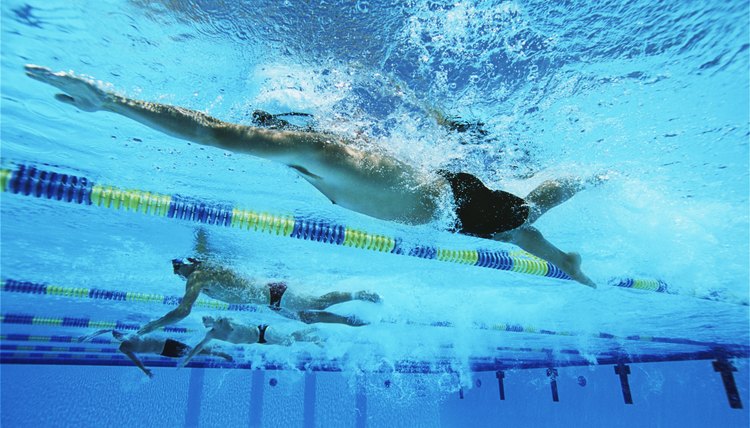What Do the Male Olympic Swimmers Wear?

In Olympic swimming, gold medalists can win by fractions of a second. Swimmers depend on their own fitness and technique to beat out the competition, but what they wear matters, too. Apart from swimsuits, racers wear swim goggles and many wear swim caps as well.
Swimsuit Evolution
In the 1930s, swimmer wore swim trunks made out of elasticized cotton. The suits were slightly baggy and covered men from the waist to the upper thigh. Over the years, swimsuits got smaller and tighter because swimmers saw them as an impediment to speed. During the 1980s, male swimmers were some of the most scantily clad Olympic competitors. Skin hugging Lycra and spandex suits left legs and torsos bare. Starting in the 2000, though, swimmers turned to new water-repellent fabrics that compressed their bodies and improved their swim times. Australian swimming champion Ian Thorpe was one of the first swimmers in Olympic competition to wear a full body suit that covered him from his neck to his ankles.
Technical Suits
In the 2008 Beijing Olympics, specialized high-tech swimsuits emerged as standard race wear. Men squeezed into body suits that functioned like girdles. Built-in panels compressed and shaped bodies into ideal hydrodynamic forms. Polyurethane materials in the suits made them impervious to water, so swimmers no longer experienced the drag causes by fabric suits. The suits even made swimmers more buoyant in the water, and gave less-fit athletes the toned abdominals others got from hours spent working out. Many world records fell, and previously unknown swimmers surged ahead in races. The results led some officials and swimmers to call for a ban on the high-tech suits. In 2010, new rules put in place by FINA, the International Federation of Swimming, prohibit the type of suits worn in the 2008 Games.
Official Rules
The rules that govern what a male swimmer can wear during Olympic swim races are complex. Torsos and lower legs must remain bare. Swimsuit fabrics must be woven textiles, and the exact blends approved vary from one brand to the next. Men usually wear jammers, which are tight-fitting swim shorts that reach from the waist to just above the knees. The competitive jammers compress and smooth the thigh area and are thinner than ordinary fitness swim trunks. FINA lists the approved suits by manufacturer and style on their website. Swimmers can wear full-body suits only for open-water events.
Continuing Controversies
Debate continues about whether to remove the world records won by swimmers wearing the high-tech bodysuits. Although officials and swimmers question the validity of the extraordinarily fast times, wiping the results off the books remains a controversial option.
References
- "The New York Times"; Polyurethane Swimsuit Ban Is Set; Karen Crouse; July 31, 2009
- Swimming World: Flip/Flop: Jammers Vs. Swim Briefs
- Sports Science; Shar Levine and Leslie Johnstone
- Scientific American: How Speedo Created a Record-Breaking Swimsuit
Writer Bio
Barrett Barlowe is an award-winning writer and artist specializing in fitness, health, real estate, fine arts, and home and gardening. She is a former professional cook as well as a digital and traditional artist with many major film credits. Barlowe holds a Bachelor of Arts in English and French and a Master of Fine Arts in film animation.
